
Centre of Jaina Studies Newsletter: SOAS - University of London
For most of the second millennium CE, Bhaṭṭārakas, or clothed, sedentary renunciants, were at the helm of the Digambara monastic lineages, surrounded by celibate brahmacārīs and lay paṇḍitas or pāṇḍes. Far less regular in this period are references to naked, peripatetic monks (muni) and nuns (āryikā). Bhaṭṭārakas were instrumental in the preservation and copying of manuscripts, and some were prolific litterateurs themselves. They held an important position in the lay community that supported them, leading pilgrimages, administering vows, and negotiating on their behalf with secular authorities. One of their most important activities was the consecration of Jina images in their capacity of pratiṣṭhācārya. In countless Digambara temples, the bhaṭṭārakas' legacy is still activated daily by the worship of Jina icons consecrated by them in past centuries.[1]
Although an important, albeit more dormant, art-historical and archeological legacy remains to evince this, it is much less well known that deceased bhaṭṭārakas themselves were also worshipped, and pavilion-shaped funerary monuments (chatrī) were erected in their honour throughout Western India. (Figure 1, 2) Most of the sites feature a number of chatrīs and are situated near former bhaṭṭāraka seats, such as Āmer, Jaipur, and Ajmer. Installed under the chatrīs are caraṇa pādukās, bas-relief carvings of the bhaṭṭārakas' feet (Figure 3, 4, 5), or, alternatively, niṣīdhikās (also nisedhikā, etc.), small pillars with carvings of Jinas as well as naked ascetics, probably bhaṭṭārakas (Figure 6).[2] Inscriptions on the pādukās and niṣīdhikās typically mention the name of the bhaṭṭāraka represented and his lineage, the date of consecration of the pādukā, and by whom it was performed, usually the immediate successor on the bhaṭṭāraka seat or sometimes the second successor in line.
The inscriptions on the pādukās and niṣīdhikās constitute an important historical archive for the study of the chronology and spread of the bhaṭṭāraka lineages yet to be studied.[3] At least as interesting is the question of their ritual function. Today most chatrīs, even those that are renovated, are visited only occasionally. At only few of the sites, offerings of water and uncooked rice are made at the pādukās, or sandalwood paste is applied.[4] However, the pādukās' former ritual function is evident from sculptural indications like drainage channels, which suggest that they were designed for the ritual oblation of liquids. A ritual (pūjā) focused on the pādukās of deceased bhaṭṭārakas is also confirmed by some textual sources, which I discuss further below.
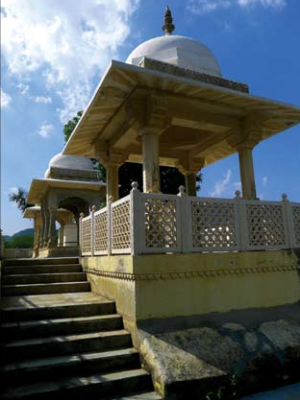
Figure 1. Bhaṭṭāraka chatrīs at the Kīrtistambh Nasiyāṃ, Amer.
Bhaṭṭāraka chatrīs seem to have been built usually at the site of cremation. Some of the sites are still used for the cremation of ascetics, as recent pādukās of Digambara munis found at Candragiri and Ṛṣabhdev-Kesariyājī show. Furthermore, although there are no external indications to prove this, it is possible that relics were buried beneath the bhaṭṭāraka chatrīs.[5] The worship of bhaṭṭāraka pādukās might also have been related to a belief that the protection and assistance of deceased bhaṭṭārakas who have been reborn in heaven can be called upon through ritual.[6] As such, the chatrīs and pādukās are not merely places of commemoration but also sites of empowerment.[7]
A preliminary survey in Rajasthan yielded about two dozen bhaṭṭāraka chatrīs, ranging from the 16th to 20th centuries, and related to all the bhaṭṭāraka lineages known to have been substantially active here. These are the Nandītaṭagaccha of the Kāṣṭhāsaṃgha and three branches (śākhā) of the Mūlasaṃgha Balātkāragaṇa: the Dillī-Jayapuraśākhā (founded at the end of the 14th century by Bhaṭṭāraka Śubhacandra, a pupil of Bhaṭṭāraka Padmanandi), the Īḍaraśākhā (founded by Bhaṭṭāraka Sakalakīrti, another pupil of Padmanandi, in Īḍar, Gujarat), and the Nāgauraśākhā (a sub-branch of the DillīJayapuraśākhā founded by Ratnakīrti in the first half of the 16th century centered on Nagaur and Ajmer).[8]

Figure 2. Bhaṭṭāraka chatrīs at the Bhaṭṭārakīya Nasiyāṃ, Jaipur.
The Mūlasaṃgha Dillī-Jayapuraśākhā is known to have shifted its seat consecutively from Delhi to Chittor, Sanganer, Āmer, Jaipur[9] and finally Mahāvīrjī. So far two sites with chatrīs of its bhaṭṭārakas have been found in Āmer and Jaipur. The Kīrtistambha Nasiyāṃ in Āmer has the chatrīs of Devendrakīrti (date in the inscription obliterated), Narendrakīrti (died VS 1722), Surendrakīrti (died VS 1733) and Jagatkīrti (pādukās consecrated VS 1771) (Plate 1). At the Bhaṭṭārakīya Nasiyāṃ in Jaipur, a platform raised on pillars supports the chatrīs of three further bhaṭṭārakas of this lineage: Mahendrakīrti (pādukās cons. VS 1853), Kṣemendrakīrti (cons. VS 1853) and Surendrakīrti (cons. VS 1881) (Figure 2). A comparison of these two sites shows the stylistic evolution of the pādukās. Those at Āmer are installed in a small shrine under the chatrī and are sculpturally rather simple (Figure 3). The later pādukās of Jaipur, installed on a low, lotus-shaped plinth, are more finely carved and stylistically more elaborate, also featuring representations of ascetics' paraphernalia like kamaṇḍalu (water pitcher), picchī (whisk) and mālā (rosary) (Figure 4). A lotus flower motif under the feet is likely an allusion to the notion of the guru's lotus-feet (pāda-padma, caraṇa-kamala).
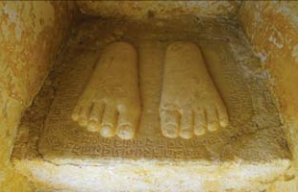
Figure 3. Caraṇa pādukā of Bhaṭṭāraka Devendrakīrti, Kīrtistambh Nasiyāṃ, Amer.
The largest chatrī site to be found in Rajasthan so far, the Āṃṭeḍ Nasiyāṃ in Ajmer (Figure 5), is related to the Mūlasaṃgha Nāgauraśākhā. It has nine chatrīs and eighteen cabūtarās, or simple octagonal platforms. Amongst these are also the pādukās of a number of paṇḍitas, installed on cabūtarās or under small chatrīs. Some of the pādukās on the site have been lost, but twenty-two remain. This site has the oldest datable bhaṭṭāraka pādukā surveyed so far, as well as some of the newest. The pādukā of Bhaṭṭāraka Ratnakīrti has an inscription dating the establishment of the chatrī to VS 1572. Two larger square carvings mounted on waist-high plinths, both consecrated by Bhaṭṭāraka Harṣakīrti in VS 1992, feature the pādukās of Bhaṭṭāraka Lalitakīrti and Ratnabhūṣaṇa, combined with the pādukās of respectively two and eight paṇḍitas.
Chatrīs of two consecutive bhaṭṭārakas of the Mūlasaṃgha Īḍaraśākhā are found on the outskirts of Udaipur. The Śantināth Digambara Jaina Mandir in Ashok Nagar has a pādukā and a niṣīdhikā of Bhaṭṭāraka Kṣemakīrti (cons.VS 1759[10]), while the Candraprabhu Digambara Jain Caityālaya at nearby Āyaḍ has a pādukā of Bhaṭṭāraka Narendrakīrti (cons. VS 1769). Another chatrī of the Īḍaraśākhā is that of Bhaṭṭāraka Candrakīrti at the Candragiri hillock in the pilgrimage place Ṛṣabhdev-Kesariyājī. This chatrī has a rare, complex niṣīdhikā (cons. VS 1869?, date difficult to read in the inscription) with caraṇa pādukās integrated into the structure at waist-height on all four sides (Figure 6). At the latter site also lies the pādukā of Bhaṭṭāraka Yaśakīrti of the Kāṣṭhāsangha Nandītaṭagaccha (VS 2035), apparently the last bhaṭṭāraka of Northern India. In Surpur, near Dungarpur, finally lies a dilapidated and overgrown site with four chatrīs and several other pādukās installed on platforms and in simple shrines. This seems to have been a cremation ground shared by several communities. Apart from pādukās of bhaṭṭārakas of the Mūlasaṃgha Īḍaraśākhā and the Kāṣṭhāsaṃgha Nandītaṭagaccha, it also has several Śvetāṃbara pādukās.[11]
As mentioned above, some textual sources evince a ritual focused on the bhaṭṭāraka pādukās. A guṭaka (bound manuscript) of the Āmera śāstra-bhaṇḍāra contains three short, Sanskrit ritual texts in praise of some of the Āmer bhaṭṭārakas mentioned above.[12] Two of these are compositions for the eightfold worship (aṣṭaprakārīpūjā) of bhaṭṭāraka pādukās. One of these two pūjās is written by Bhaṭṭāraka Jagatkīrti in worship of his guru Surendrakīrti, while the other worships Jagatkīrti himself.
Explicitly referring to the pādukās (guruṇaṃ caraṇa, padapadma, etc.), these texts prescribe the offering of the usual eight substances of bīspanthī aṣṭaprakārī-pūjā: jalaṃ (water), gandhaṃ or caṃdanaṃ (sandalwood), akṣataṃ (unbroken rice), puṣpaṃ (flowers), caruḥ or naivedyaṃ (sweets or sugar), dīpaṃ (lamps), dhūpaṃ (incense), and phalaṃ (fruits). The first composition has the invocation formula (āhvānana) typically used at the start of Digambara pūjā liturgy. Using several seed syllables, this invocation calls the object of veneration to the vicinity of the worshipper, for the purpose of worship: oṃ hrīṃ paramacātrapātraguruṇaṃ caraṇa | atrāvatarāvatara saṃvauṣaṭ āhvānanaṃ (om hrīm, [may] the feet of the supreme guru, invocated, incarnate here, incarnate, samvausat). While the third composition merely praises Bhaṭṭāraka Jagatkīrti, without mentioning the eight substances, it also refers to the 'establishing' (sthāpanaṃ) of the pādukās.[13]

Figure 4. Caraṇa pādukā of Bhaṭṭāraka Mahendrakīrti, Bhaṭṭārakīya Nasiyāṃ, Jaipur.
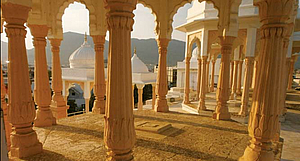
Figure 5. Āṃṭeḍ Nasiyāṃ, Ajmer.
Today, the medieval Northern Indian bhaṭṭārakas are predominantly perceived as a kind of cleric, credited with the preservation of the Digambara tradition during the 'inauspicious' period of Muslim rule, but devoid of any ascetic charisma. The installation and worship of bhaṭṭāraka pādukās, however, is an indication of their contemporaries' devotion towards them. It shows the importance of the 'devotion of asceticism'[14] in Digambara Jainism and the continuity of the worship of the ascetic ideal even when the 'ideal' (i.e. naked and peripatetic) ascetic was hard to come across. At this time, it would seem, the practices and feelings of devotion and worship of asceticism were projected on the bhaṭṭārakas, even when the latter only took the minor vows. This alters and enriches our understanding of the late medieval Northern Indian bhaṭṭāraka institution. In the framework of the research project 'North Indian Digambara Jainism (13th17th century): the Age of the Bhaṭṭārakas', my ongoing PhD research at Ghent university, I aim to continue surveying bhaṭṭāraka chatrīs, pādukās and niṣīdhikās, and researching the broader phenomenon of the bhaṭṭāraka tradition throughout the wider region.
All photos are by the author.
Tillo Detige obtained an MFA from the School of Arts Ghent in 2003, and an MA in Eastern Languages and Cultures (Indology) from Ghent University in 2009. He began his PhD research on the North-Indian Bhaṭṭārakas in September 2012 at Ghent University, under the supervision of Eva De Clercq and aided by a scholarship granted by the Research Foundation Flanders.
References
Babb, L.A., Absent Lord: Ascetics and Kings in a Jain Ritual Culture, University of California, 1996.
Cort, J.E., 'A Tale of Two Cities: On the origins of Digambara Sectarianism in North India.' In: L. A. Babb, V. Joshi and M. W. Meister (eds.), Multiple Histories: Culture and Society in the Study of Rajasthan. Rawat Publications, 2002a, 39-83.
Cort, J.E. 'Singing the Glory of Asceticism: Devotion of Asceticism in Jainism', Journal of the American Academy of Religion vol. 70, no. 4, 2002b, 719-42.
Deo, S.B., History of Jaina Monasticism from Inscriptions and Literature. (Deccan College Dissertation Series, Vol. 16.) Deccan College, Poona, 1956.
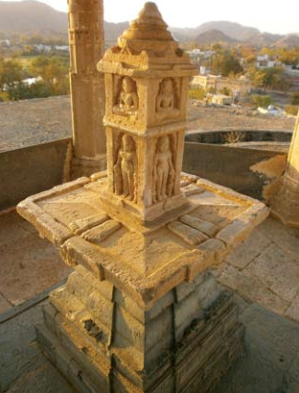
Figure 6. Niṣīdhikā of Bhaṭṭāraka Candrakīrti, Candragiri, ṚiṣabhdevKesariyājī.
Flügel, P., 'Demographic Trends in Jaina Monasticism.' In: P. Flügel (ed.) Studies in Jaina History and Culture - Disputes and Dialogues. Routledge, London, 2006, 312-98.
Flügel, P., 'Jaina Relic Stūpas', CoJS Newsletter, no. 3, 2008, 18-23.
Flügel, P., 'The Jaina Cult of Relic Stupas', Numen, vol. 57, 2010, 389-504.
Flügel, P., 'Burial Ad Sanctos at Jaina Sites in India', International Journal of Jaina Studies (Online), vol. 7, no. 4, 2011, 1-37.
Jain, M.U.K., Jaina Sects and Schools. Concept Publishing Company, New Delhi, 1975.
Johrāpurkar, V.P., Bhaṭṭāraka Sampradāya. Jaina Samskriti Samrakshaka Sangha, Sholapur, 1958.
Hoernle, A.F.R., 'Three Further Pattavalis of the Digambaras.' Indian Antiquary. Vol. XXI, 1892, 57-84.
Kāslīvāl, K.C., Rājasthāna ke Jain Sant: Vyaktitva evaṃ Kṛtitva. Śrī Di. Jaina A. Kṣetra Śrī Mahāvīrajī, Jayapura, 1967.
Laidlaw, J., Riches and Renunciation: Religion, Economy, and Society among the Jains, Oxford University Press, Oxford, 1995.
Johrāpurkar 1958 remains the most important study of the North Indian bhaṭṭārakas so far. K.C. Kāslīvāl has studied the literary output of the bhaṭṭārakas of Rajasthan and Gujarat and their brahmacārī pupils in a number of monographs (i.e. his 1967). See also Deo 1956: 545-58, Jain, M.U.K. 1975: 83-132, Cort 2002a, Flügel 2006: 344-7.
The inscriptions on most niṣīdhikās do not indicate whether they indeed depict bhaṭṭārakas. However, kīrti-stambhas, a type of pillar found in Āmer, Dungarpur and Sāgvāḍā featuring carvings of the successive pontiffs of the monastic lineage, carry similar representations of naked bhaṭṭārakas with inscriptions of their names and dates.
Johrāpurkar 1958 included none of the inscriptions of the sites discussed below. The prevalence of the construction of bhaṭṭāraka chatrīs has not yet been noticed, let alone has any sustained study of these sites been conducted.
The Vidyānandi Kṣetra in Surat, is a notable and so far rare exception. Here, an annual festival (mela) is still held on the death anniversary of Bhaṭṭāraka Vidyānandi, the second occupant of the Mūlasaṃgha Sūrataśākhā (VS 1499-1537).
Relic worship is a controversial issue amongst both the Digambaras and the Śvetāṃbaras. See Flügel 2008, 2010, 2011. While it is sometimes deprecated as not ordained by scriptures or as impure, I have heard attestation of the inclusion of vessels with relics under chatrīs of several contemporary Digambara ācāryas and munis (a.o. Ācārya Bharatsāgara at Aḍindā, 2011; Ācārya Yogīndrasāgara at Sāgvāḍā, under construction), as well as of the currency of this practice.
For parallels of Śvetāmbara monks who are believed to have been reborn as gods and as such can offer assistance and protection as 'miracle workers' (camatkārī), see Laidlaw 1995: 51, and 71ff; Babb 1996: 108
Another niṣīdhikā installed under this chatrī in the same year is that of Ācārya Viśvabhūṣaṇa. It is not clear whether the title ācārya here refers to a naked monk.
I have meanwhile surveyed further sites in Rajasthan (Aḍindā, Sāgvāḍā, Naugāmā, Pratāpgaṛh, Bijauliyāṃ and Būndī), Madhya Pradesh (Sonagiri and Gwalior) and Gujarat (Surat and Īḍar). The Vidyānandi Kṣetra in Surat features no less than eighty-two pādukās, amongst which many of bhaṭṭārakas, of multiple lineages. A single chatrī in Sāgvāḍā has eighteen niṣīdhikās related to the Īḍaraśākhā and Bhānapuraśākhā of the Mūlasaṃgha.
I have recently found several more similar bhaṭṭāraka pādukā pūjā compositions in guṭakas preserved in temple manuscript collections in Ankleśvar and Īḍar, both in Gujarat. Aṣṭaprakārī-pūjās of modern Digambara ācāryas have now become popular and can be found in many editions of collected pūjā texts. While the verses are now more often written in Hindi, the same Sanskrit ritual formulas are still used.
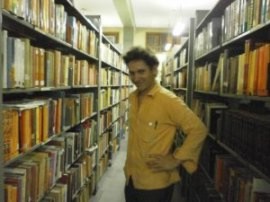 Tillo Detige
Tillo Detige